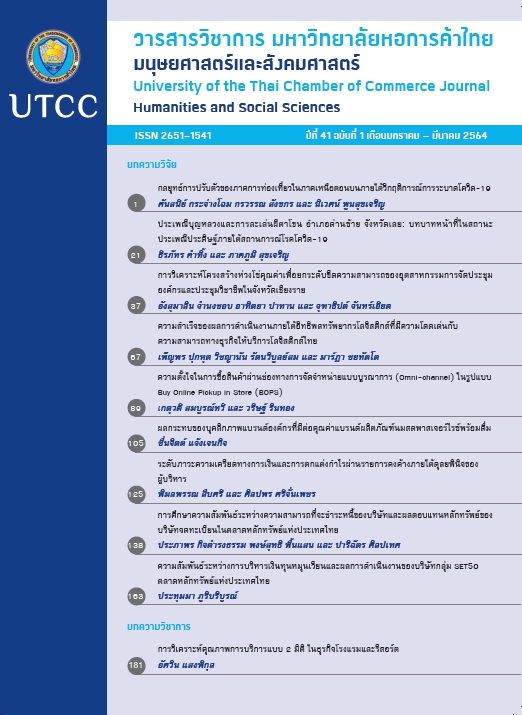An analysis of Value Chain for Enhancing Corporate Meeting and Conference Industry’s Capability in Chiang Rai
Main Article Content
Abstract
This research aims to study 1) the patterns and decision making behaviors to join the meeting in Chiang Rai province 2) analyze value chain structure of the meeting industry 3) study trends of meeting industry in Chiang Rai province and, 4) propose guidelines for the development of the value chain to enhance the capability of the meeting industry in Chiang Rai.Research methodologies were mixed between qualitative and quantitative research. It was found
that the meetings industry in Chiang Rai had a possibility and a good direction, especially in the Special Economic Zone. It could be good opportunities to create competitive advantages that affected to local economic both directly and indirectly. For value chain development approach
to enhance the capabilities of the meeting industry in Chiang Rai which related to 7 approaches consisting of 1) establish the MICE Excellence Center 2) improve and develop meeting facilities 3) build a business collaboration network 4) develop human resources in the meeting industry 5) develop activities to accommodate MICE tourists 6) make a difference by using the provincial identity and 7) create media to promote the meeting industry of Chiang Rai province.
Article Details

This work is licensed under a Creative Commons Attribution-NonCommercial-NoDerivatives 4.0 International License.
ลิขสิทธิ์ของบทความ
ผลงานที่ได้รับการตีพิมพ์ถือเป็นลิขสิทธิ์ของมหาวิทยาลัยหอการค้าไทย ห้ามมิให้นำเนื้อหา ทัศนะ หรือข้อคิดเห็นใด ๆ ของผลงานไปทำซ้ำ ดัดแปลง หรือเผยแพร่ ไม่ว่าทั้งหมดหรือบางส่วนโดยไม่ได้รับอนุญาตเป็นลายลักษณ์อักษรจากมหาวิทยาลัยหอการค้าไทยก่อน
References
ณรงค์ศักดิ์ โอสถธนากร.(2560).การประชุมสัมมนาเชิงปฏิบัติการพลิกเชียงรายสร้างเมืองไมซ์แปลงเศรษฐกิจ เปลี่ยนวิถีชีวิตอย่างยั่งยืนภายใต้โครงการส่งเสริมความร่วมมือกับประเทศอาเซียน+6 และGMS เพื่อรองรับการเจริญเติบโตทางเศรษฐกิจ.สืบค้นเมื่อ 29เ มษายน 2561,จากhttps://www.
chiangmainews.co.th/page/archives/628552/
ภูริวัจน์ เดชอุ่ม.(2553).การพัฒนากลยุทธ์การเสนอขอเป็นเจ้าภาพจัดการประชุมนานาชาติของประเทศไทย.E-TAT Tourism Journal,(1),1-12.
มหาวิทยาลัยศิลปากรและสมาคมส่งเสริมการประชุมนานาชาติ (ไทย).(2562). หลักสูตรการจัดประชุมองค์กร และประชุมวิชาชีพอย่างมืออาชีพ.กรุงเทพฯ: สำนักงานส่งเสริมการจัดประชุมและนิทรรศการ.
สำนักงานส่งเสริมการจัดประชุมและนิทรรศการ.(2556).การพัฒนาศักยภาพอุตสาหกรรมไมซ์:มาตรฐานอุตสาหกรรมไมซ์.สืบค้นเมื่อ 29เมษายน2561,จากhttps://www.businesseventsthailand.com/ th/why-thailand/mice-capabilities/mice-standards/
สำนักงานส่งเสริมการจัดประชุมและนิทรรศการ.(2560).ทิศทางกลยุทธ์ไมซ์ไทยประจำปีงบประมาณพ.ศ.2560.สืบค้นเมื่อ 29 เมษายน2561,จาก https://www.businesseventsthailand.com/
สำนักงานส่งเสริมการจัดประชุมและนิทรรศการ.(2564). ทำความรู้จักกับ “BleisureTravel”เทรนด์การเดินทาง ที่ผสมผสานเรื่องธุรกิจและการพักผ่อนเข้าไว้ด้วยกัน.สืบค้นเมื่อ11 มกราคม 2564,จากhttps://intelligence.businesseventsthailand.com/th/blog/bleisure-travel
สำนักเศรษฐกิจอุตสาหกรรมระหว่างประเทศ.(2557).อุตสาหกรรมไมซ์ในภูมิภาคเอเชีย. สืบค้นเมื่อ 29เมษายน2561,จาก https://www.businesseventsthailand.com/uploads/press_media/file/190903-fileHVPWyZuJ1.pdf
Cochran,W.G.(1977).Sampling techniques(3rded.).NewYork: JohnWiley&Sons Convention Industry Council.(2012). The economic significance of meetings to the U.S. economy.
Fort Lauderdale, FL:PricewaterhouseCoopersLLP.
Crouch, G. I., & Ritchie, J. R. B. (1999). Tourism, competitiveness, and societal prosperity. Journal
of Business Research, 44(3), 137-152.
Goldblatt, J., & Nelson, K. S. (2012). The international dictionary of event management (2nd ed.).
Canada: John Wiley & Son.
Hassan, S. S. (2000). Determinants of market competitiveness in an environmentally sustainable
tourism industry. Journal of Travel Research, 38(3), 239-245.
Jin, X., Bauer, T., & Weber, K. (2008). China’s second-tier cities as exhibition destinations. International
Journal of Contemporary Hospitality Management, 22(4), 552-571.
Mair, J., & Jago, L. (2010). The development of a conceptual model of greening in the business
events tourism sector. Journal of Sustainable Tourism, 18(1), 77-94.
Oppermann, M., & Chon, K. (1997). Convention participation decision-making process. Annals of
Tourism Research, 24(1), 178-191.
Porter, M. E. (1985). The competitive advantage: Creating and sustaining superior performance.
New York: Free Press.
Porter, M. E. (1998). Competitive advantage revisited: Michael Porter on strategy and competitiveness.
Journal of Management, 16(3), 256-273.
Reiser, T. (2019). Site Management. Events Industry Council Manual, 9th edition: Washington, DC,
Events Industry Council.
Ritchie, J. B. B., & Crouch, G. I. (2000). The competitiveness destination: A sustainability perspective.
Tourism Management, 21(1), 1-7.
Rittchainuwat, B., Nelson, R., & Rahmafitria, F. (2018). Applying the perceived probability of risk
and bias toward optimism: Implications for travel decisions in the face of natural disasters.
Tourism Management, 66, 221-232.
The International Association of Professional Conference Organizer. (2015). Corporate meeting.
Retrieved April 30, 2018, from https://www.iapco.org/publications/on-line-dictionary/
dictionary/
Union of International Associations. (2011). What UIA does for the meetings industry. Retrieved
April 30, 2018, from https://uia.org/uia-for-meetingsindustry


